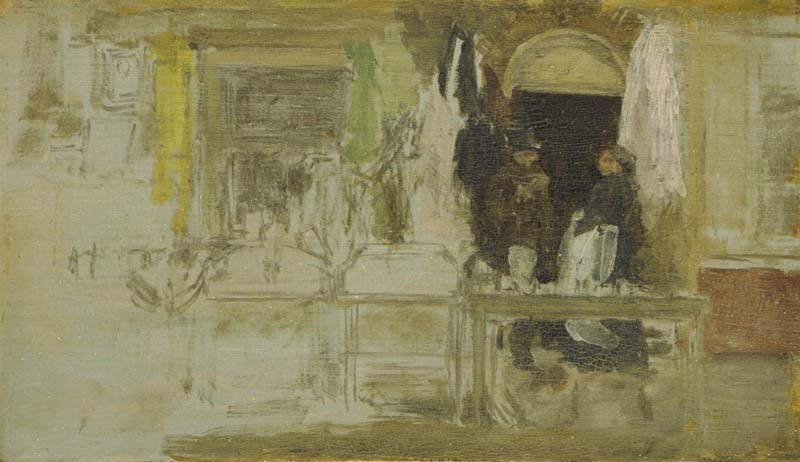Home > Catalogue > Browse > Old Clothes Shop, Houndsditch << >>
Technique
It was painted on a panel made from a single piece of timber about 1 cm deep. It was primed with a pale grey underpaint, visible as left to right brushmarks, and left bare over much of the surface, particularly at left. 1 The outlines of the composition were sketched, possibly in charcoal, and then with a brush in short strokes of grey paint to emphasise the drawing, but the picture was left unfinished. Only some areas – like the doorway, the two figures and goods near them – have been coloured. However, there is a wide range of subtly varied colours: yellow ochre, light and dark brown and grey, Indian red, a pink that may be Indian red mixed with white for the hanging clothes, and green and yellow for other clothes. 2 The white cloth hanging in the doorway at right looks as if it has been scraped with the end of the brush or a palette knife.
There is a thin and very yellowed varnish with linear craquelure (crazing) suggestive of dried egg white, which is most obvious over the figures and the shadows and doorway behind them. This may have been applied by Whistler to fix the charcoal-like material used for drawing, or so that he could see the effect of varnish on the only completed area of the picture.
This is typical of Whistler's method of working, outlining the overall design on a prepared panel before working up individual areas in greater detail.
Conservation History
The panel has some damage on the short sides from sliding it into a paintbox before the paint dried.
There is some fine craquelure and drying cracks. The panel has a small split at the top edge. There appears to have been some retouching but it is not certain whether that was done by the artist or a restorer. 3
The wood panel has an auxiliary backing and framing device, both made from mahogany-type hardwood, with adhered thin battens that have mitred corners. The overall varnish, which extends over the battens, is slightly yellowed. 4 This form of auxiliary backing was almost certainly done after Whistler's death.
Frame
32.5 x 41.5 x 3.2 cm.
Last updated: 22nd October 2020 by Margaret






